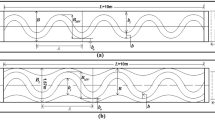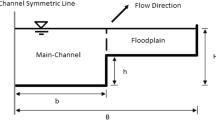Abstract
In the recent years, compound channels received more attention in hydraulic engineering for their role in estimating and calculating the hydraulic parameters of natural rivers. Usually, for determination of the hydraulic parameters of compound channels, physical models are used which have cost and time assumption. According to the wide usage of numerical modeling in hydraulic engineering, this paper aims to evaluate the accuracy of numerical models in compound channels by simulating the hydraulic parameters in nine different types of compound channels and to compare them with experimental data. These simulations can show the interaction between velocity and vorticity and other hydraulic parameters by using contours and graphs along the channel length which help to have more and better understanding about their changes. Numerical simulations were performed using the renormalization-group turbulence model and volume-of-fluid free surface model for determining the level of fluid. Values of convergence ratio and the grid convergence index were calculated for evaluating the extrapolated values from numerical modeling and the sensitivity of the model solution to the numerical discretization, respectively, which indicates a proper validation of grid spacing and refinement selection for optimizing the calculation process. The comparison between numerical and experimental results shows a good agreement. The extracted numerical results show that by changing the floodplain width and depth, the water surface level changes 4–20% and 5–34%, respectively. Moreover, the numerical results show an increment of 20 and 145% in Froude and Weber numbers in floodplains, respectively, because of increment of velocity in floodplain.


























Similar content being viewed by others
Abbreviations
- A :
-
The fractional area open to flow
- B :
-
Width of main channel
- B o :
-
Width of upstream channel
- B f :
-
Width of floodplain
- D :
-
Hydraulic diameter
- f i :
-
The result corresponding to the different mesh sizes
- F SOR :
-
The time rate of change of the volume fraction of fluid associated with the mass source for fluid
- Fr :
-
Froude number
- f x , f y and f z :
-
Viscous accelerations
- g :
-
Earth gravity
- G x , G y and G z :
-
Body accelerations
- H :
-
Main channel water depth
- K :
-
The turbulence kinetic energy
- Q 1 :
-
Mean main channel volumetric flow rate
- Q 2 :
-
Mean floodplain volumetric flow rate
- Q 3 :
-
Mean full cross-sectional volumetric flow rate
- R ’ :
-
Refinement factor
- R :
-
The center of mass of a body
- R c :
-
The convergence ratio
- R DIF :
-
A turbulent diffusion term
- R SOR :
-
A mass source
- u w, v w and w w :
-
The velocity of source component
- u s, v s and w s :
-
The velocity of the fluid at the surface of the source relative to the source itself
- V :
-
Mean cross-sectional velocity
- V F :
-
The fractional volume open to flow
- We :
-
Weber number
- x, y and z :
-
Coordinate directions
- u, v and w :
-
Velocity components
- Y f :
-
Floodplain water depth
- Y r :
-
The ratio of floodplain water depth and main channel water depth
- Z :
-
Step height
- θ 1 :
-
Entrance angles
- θ 2 :
-
Entrance angles
- ρ :
-
The fluid density
- ε i + 1,i :
-
The relative deviation
- ε :
-
Dissipation rate
- v t :
-
Eddy viscosity
- v :
-
The kinematic viscosity
- Δh :
-
The grid spacing
- σ :
-
Surface tension
References
Knight DW, Brown FA (2001) Resistance studies of overbank flow in rivers with sediment using the flood channel facility. J Hydraul Res 39(3):283–301
Karamisheva RD, Lyness JF, Myers WRC, Cassells JBC, O’Sullivan J (2006) Overbank flow depth prediction in alluvial compound channels. Proc Ice Water Manag 159(3):195–205
Carollo FG, Ferro V, Termini D (2002) Flow velocity measurements in vegetated channels. J Hydraul Eng 128(7):669–673
Seckin G (2004) A comparison of one-dimensional methods for estimating discharge capacity of straight compound channels. Can J Civ Eng 31(4):619–631
Al-Khatib IA, Dweik AA, Gogus M (2012) Evaluation of separate channel methods for discharge computation in asymmetric compound channels. Flow Meas Instrum 24:19–25
Luo EC (2011) Apparent shear stress in symmetric-straight compound-channel flow. Int J Environ Prot 1(2):28–32
Bousmar D, Wilkin N, Jacquemart JH, Zech Y (2004) Overbank flow in symmetrically narrowing floodplains. J Hydraul Eng 130(4):305–312
Rezaei B, Knight DW (2011) Overbank flow in compound channels with nonprismatic floodplains. J Hydraul Eng 137(8):815–824
Meile T, Boillat J, Schleiss A (2011) Flow resistance caused by large-scale bank roughness in a channel. J Hydraul Eng 137(12):1588–1597
Sahu M, Mahapatra SS, Biswal KC, Khatua KK (2014) Prediction of flow resistance in a compound open channel. J Hydroinform 16(1):19
Hosseini SM (2004) Equations for discharge calculation in compound channels having homogeneous roughness. Iran J Sci Technol 28(B5):538–546
Sahu M, Khatua KK, Mahapatra SS (2011) A neural network approach for prediction of discharge in straight compound open channel flow. Flow Meas Instrum 22(5):438–446
Zeng YH, Guymer I, Spence KJ, Huai WX (2012) Application of analytical solutions in trapezoidal compound channel flow. River Res Appl 28(1):53–61
Zahiri A, Dehghani AA (2009) Flow discharge determination in straight compound channels using ANNs. Int Sci Index 3(10):12–15
Chau KW, Jiang YW (2004) A three-dimensional pollutant transport model in orthogonal curvilinear and sigma coordinate system for Pearl river estuary. Int J Environ Pollut 21(2):188–198
Chau KW, Jiang YW (2001) 3D numerical model for Pearl River estuary. J Hydraul Eng 127(1):72–82
Yazdi J, Sarkardeh H, Azamathulla HM, Ghani AA (2010) 3D simulation of flow around a single spur dike with free-surface flow. Int J River Basin Manag 8(1):55–62
Rahimzadeh H, Maghsoodi R, Sarkardeh H, Tavakkol S (2012) Simulating flow over circular spillways by using different turbulence models. Eng Appl Comput Fluid Mech 6(1):100–109
Maghsoodi R, Roozgar MS, Sarkardeh H, Azamathulla HM (2012) 3D-simulation of flow over submerged weirs. Int J Model Simul 32(4):237–245
Sarkardeh H, Zarrati AR, Jabbari E, Marosi M (2014) Numerical simulation and analysis of flow in a reservoir in the presence of vortex. J Eng Appl Comput Fluid Mech 8(4):598–608
Maghsoodi R, Roozgar MS, Chau KW, Sarkardeh H (2012) 3D simulation of dam break flows. Dam Eng 23(2):53–60
Atabay S, Knight DW, Seckin G (2005) Effects of overbank flow on fluvial sediment transport rates. Proc Ice Water Manag 158(1):25–34
Maghrebi MF, Ball JE (2006) New method for estimation of discharge. J Hydraul Eng 132(10):1044–1051
Jan C, Chang CF (2009) Experiments on discharge equations of compound broad crested weirs. J Irrig Drain Eng 135(4):511–515
Nguyen VT, Moreno CS, Lyu S (2014) Numerical simulation of sediment transport and bed morphology around Gangjeong Weir on Nakdong River. KSCE J Civ Eng 19(7):2291–2297
Nazari O, Jabbari E, Sarkardeh H (2015) Dynamic pressure analysis at chute flip buckets of five dam model studies. Int J Civ Eng 13(1A):45–54
Kazemi F, Khodashenas SR, Sarkardeh H (2016) Experimental study of pressure fluctuation in stilling basins. Int J Civ Eng 14(1):13–21
Fazel Z, Fazelian M, Sarkardeh H (2016) Development of a device for measuring air-water flow characteristics. Int J Civ Eng 15(1):45–54
Ferziger JH, Peri M (2002) Computational method for fluid dynamics. Springer, Berlin
Thanh NC, Ling-Ling W (2015) Physical and numerical model of flow through a spillway with a breast wall. KSCE J Civ Eng 19(7):2317–2324
Gaulke D, Dreyer ME (2015) CFD simulation of capillary transport of liquid between parallel perforated plates using Flow 3D. Microgravity Sci Technol 27(4):261–271
Abbaspour A, Hashemi-kia S (2014) Numerical investigation of turbulent open channel flow with semi-cylindrical rough beds. KSCE J Civ Eng 18(7):2252–2260
Kang H (2013) Flow characteristics and morphological changes in open-channel flows with alternative vegetation zones. KSCE J Civ Eng 17(5):1157–1165
Al-khatib IA, Hassan HA, Abaza KA (2013) Application and validation of regression analysis in prediction of discharge in asymmetric compound channel. J Irrig Drain Eng 139:542–550
Shahheidari H, Nodoshan EJ, Barati R, Moghadam MA (2015) Discharge coefficient and energy dissipation over stepped spillway under skimming flow regime. KSCE J Civ Eng 19(4):1174–1182
Ali MSM, Doolan CJ, Wheatley V (2009) Grid convergence study for a two dimensional simulation of flow around square cylinder at a low reynolds number. In: Proceeding of 7th International Conference on CFD in the Minerals and Process Industries, CSIRO, Melbourne, Australia, pp 1–6
Aydin MC, Ozturk M (2009) Verification and validation of a computational fluid dynamics (CFD) model for air entrainment at spillway aerators. Can J Civ Eng 36(5):826–836
Wilcox DC (2007) Turbulence modeling for CFD, 3rd edn. DCW Ind Inc, California
Kumbhakar M, Ghoshal K (2016) Two dimensional velocity distribution in open channels using Renyi entropy. Phys A 450:465–559
Author information
Authors and Affiliations
Corresponding author
Ethics declarations
Funding
No fund available in this research work.
Rights and permissions
About this article
Cite this article
Sajjadi, SAH., Sajjadi, SH. & Sarkardeh, H. Accuracy of Numerical Simulation in Asymmetric Compound Channels. Int J Civ Eng 16, 155–167 (2018). https://doi.org/10.1007/s40999-016-0113-3
Received:
Revised:
Accepted:
Published:
Issue Date:
DOI: https://doi.org/10.1007/s40999-016-0113-3




